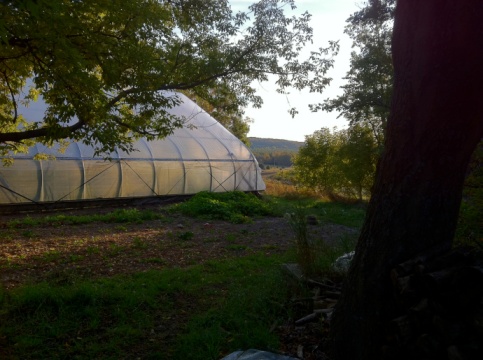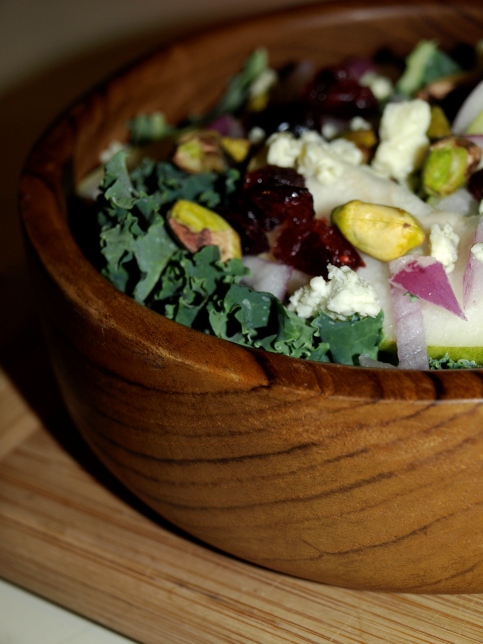swiss chard
A “Pear” of Winter Salads
Winter is infamous for warm soups, hearty meat & potatoes and any kind of meal that sticks to your bones. Those dishes are certainly welcomed and savored on these seasonally cold days, but this is a reminder (to myself and to you!) never forget your greens! As snow piles up in many regions across the world, a majority of us inherently become less active. Of course there are people that provide an exception to this idea, but if you’re honest warm weather pulls you out the door, while colder weather keeps you curled up by the fire.

(a season-extending hoophouse at Birch Point Farm)
Local greens, at least in Michigan, are harder to come by in the winter for obvious reasons, but as the infrastructure for winter growing develops in our region we’re likely to see an increase in the availability of hearty greens throughout the colder months. In the past few years the number of hoophouses and greenhouses in Northwest Michigan has increased dramatically. This is in large part due to programs like the Hoophouses for Health Loan Program made possible by the W.K. Kellogg Foundation and administered by Michigan State University and The Michigan Farmers Market Association.
Programs like this reduce the upfront cost for the Farmer and thereby increase availability for fresh local produce to our communities. If you’re unfamiliar with hoophouses, let me explain it here briefly. A hoophouse, like a greenhouse, is a method of extending the growing season; however a hoophouse is typically shaped like a semi-circular tunnel and wrapped with polyethylene (common plastic). The hoophouse traps warmth from the sun and soil allowing hearty greens (think: kale, collards, mustard greens, swiss chard, etc. ) to grow well into the cold depths of winter.

Some of my favorite salads are filled with hearty greens & root veggies, the harvest of a Michigan Winter. I thought I’d share with you a few of my go-to salad combinations and a couple delicious homemade vinaigrettes to keep you thinking “greens” even in the heart of winter.
Kale Salad with Sliced Pears, Gorgonzola, Pistachios & Dried Cranberries:
1 bunch Kale
1/2 medium red onion, diced
1/3 cup dried cranberries
1/3 cup roasted pistachios
1 ripe pear, sliced
Gorgonzola cheese
Homemade Honey Cumin Vinaigrette:
1/2 cup red wine vinegar
1/2 olive oil
2 tsp cumin
2 tsp garlic salt
2 tbsp Dijon Mustard
2 tsp honey
Carrot & Beet Salad with Roasted Pumpkin Seeds & Garbanzo Beans:
3 medium-sized beets, peeled and cut into 1/2″ wedges
3 medium-sized carrots, quartered length-wise
1/3 cup roasted pumpkin seeds
1/3 cup cooked, drained garbanzo beans
2 tsp honey
2 tbsp white wine vinegar
1 bunch lettuce greens
Melt butter and olive oil in a covered skillet over medium heat and add beets, stirring occasionally. After ten minutes, add carrots and cook until tender (about 6 minutes). Add honey and white wine vinegar, until tender and lightly glazed, about 2-3 minutes. Transfer vegetables to a large bowl to cool.

Homemade Tahini Citrus Vinaigrette:
2 tbsp white wine vinegar
2 tbsp lemon juice
1/2 tsp ground cumin
2 tbsp tahini
whisk together in skillet over low heat, toss greens and garbanzo beans lightly.
top with beets, carrots, and pumpkin seeds. Enjoy!
Winter Salads help to keep those of us chilly-weathered homebodies weighing lighter on the scale, but their nutrients also increase energy and help us from feeling lethargic. We can look forward to the days of bountiful winter produce in Michigan with season-extending infrastructure like hoophouses and greenhouses. Personally I’m grateful for the ingenuity of our local farmers and organizations who’ve made it their mission to increase winter vegetable production and support farmers in need. Without them, our available local produce from December-March would equate to nothing more than seedlings under snowdrifts.
Go Green(s)!
love,
tricia









